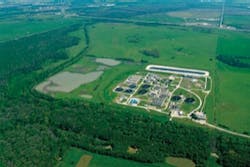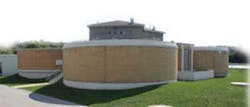Upgrade Project Improves Energy Efficiency at WWTP
By Mike Dahlquist
Peru, IN, is a town of nearly 16,000 located on the banks of the Wabash River. It is one of the few cities in the state with combined sewers. Peru needed to upgrade its two wastewater treatment facilities to reduce operations costs and expand capacity to promote economic growth. The town also needed to upgrade its old main plant to handle stormflows as high as 26 mgd.
The pre-upgrade process at this plant was a conventional activated sludge process that consisted of primary clarification, fine-bubble aeration, and anaerobic digestion. The process was limited because dry weather flow was 4 mgd, and the wet weather flow was rated at 6 mgd. So if Peru had a significant rain event, the utility was automatically limited in how it could use the process.
Additionally, sludge that remained from the treatment process had to be trucked out, which involved a lot of expense. Peru had to pay the sludge hauling contractor and all of the associated trucking bills. At the high point, the town was hauling away an average of 1.8 million gallons of solids annually. The time and cost added up fairly quickly.
VLR systems, pictured in the foreground, are the main element of the facility. Tow-Bro high-performance final clarifiers can be seen in the background.
In short, Peru Utilities needed to find a solution that would address future needs of the community as well as the combined sewer overflows the town was experiencing.
Plant Upgrades
In 2004, Peru upgraded the main wastewater treatment plant (WWTP) from 4 to 8 mgd, using a BioFlowsheet+™ Solution from Siemens Water Technologies. The design required minimal modifications to the existing plant: abandoning the primary clarifiers, converting the aeration tanks to VLR® systems (vertical loop reactors), and turning the anaerobic digesters into Cannibal® interchange reactors. The utility also added two new VLR tanks, three new Tow-Bro® high-performance final clarifiers, and the Cannibal solids reduction system.
Part of the plant retrofit included turning the anaerobic digesters into Cannibal interchange reactors.
All biological processes associated with treatment of the waste stream take place in the VLR systems, which are the main element of the facility. Peru takes the return sludge from the clarifiers and puts it into the return sludge holding tank. The utility is batch-feeding two Cannibal tanks. Reducing the amount of solids through the Cannibal system has allowed Peru to gain better control as it re-introduces the solids back into the VLR systems. The VLR and Cannibal systems are working together in tandem to condition the facility's sludge. The organisms that thrive best in the non-aerobic environment of the Cannibal interchange tanks thrive equally as well in the oxygen-deficient conditions of the VLR tanks.
One of the three new Tow-Bro high-performance final clarifiers added to the main plant.
Using an aeration process that is compatible with the Cannibal system has been essential. Oxidation reduction potential (ORP) probes control the oxygen delivery for the VLR tanks. Four VLR tanks operate in series – the first three with zero dissolved oxygen. The entire air delivery for individual tanks is often turned off for several hours. The new Cannibal interchange tanks only use about 10 hours of air delivery per week.
VLR tanks typically use disc aerators on the surface and coarse-bubble diffusers under the intermediate baffle. Disc aerators at the Peru WWTP typically run at 4 to 12 hp; Peru seldom has to use coarse-bubble diffusers. With a total of 300 installed horsepower, the blowers associated with these diffusers were formerly used with the fine-bubble diffusers.
Savings, Increased Capacity
The upgrade has proven to be a great success. In addition to increasing the Peru's dry weather flow to 8 mgd, the upgrade has also allowed the facility to handle storm flows up to 26 mgd without violating effluent discharge quality. Effluent quality is substantially better than pre-upgrade – with final effluent BOD below 5 mg/l, nitrate and phosphorus levels close to 1 mg/l and ammonia non-detectable when operations are optimized. Additionally, MLSS, which tends to range from 4,000 to 8,000 mg/l, has been as high as 10,000 mg/l. TSS in the effluent is consistently below 10 mg/l and most often below 5 mg/l.
The upgrade also reduced aeration energy cost by a factor of 3:1. Doing away with anaerobic digestion greatly reduced the utility's operating costs. That was very cost-expensive in natural gas – about $50,000 annually. Peru completely eliminated this expense with the installation of the Cannibal solids reduction system.
In addition, Peru reduced waste sludge disposal by a factor of 10:1. The utility saves a lot of money on sludge hauling costs as it only has to haul sludge away about once a year, if that. When it hauled sludge in 2005 before the plant upgrade was completed, Peru was spending between $45,000 and $50,000 a year for sludge hauling operations. The utility just hauled about 800,000 gallons of sludge in 2009, at an expense of about $30,000.
Post-upgrade, Peru's plant is now on the cutting edge of technology, allowing the utility to reduce both aeration power and solids while simultaneously improving effluent quality. With the new system, Peru is able to process more efficiently at beneficial cost savings.
Second Upgrade in the Works
Peru has been so happy with the main plant upgrade that it decided to install similar technology (minus the Cannibal system) at the new Grissom WWTP. The plant will be commissioned in April 2011.
Peru feels investing in its WWTPs' future will prove to be one of the best long-term investments for its citizens.
About the Author:Mike Dahlquist is the water superintendent at Peru Utilities, in Peru, IN. Dahlquist is a Class IV, Class D Indiana Certified Operator, a Class 1 Illinois Certified Operator and has a Masters in Business Administration from Indiana Wesleyan University in Marion, Indiana. He can be reached at [email protected].



